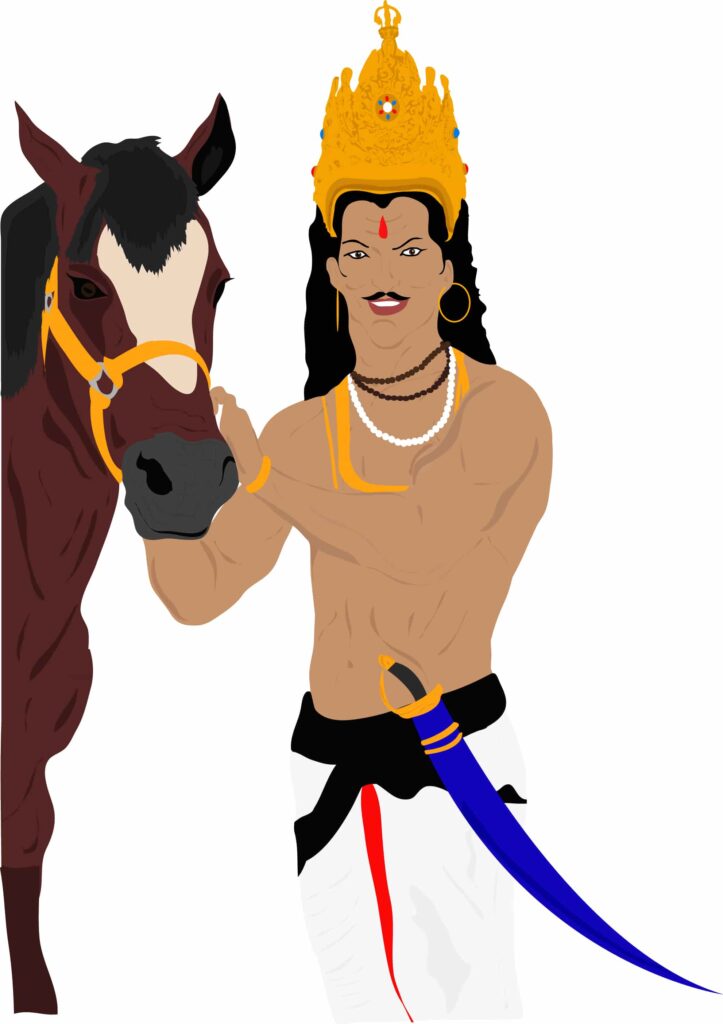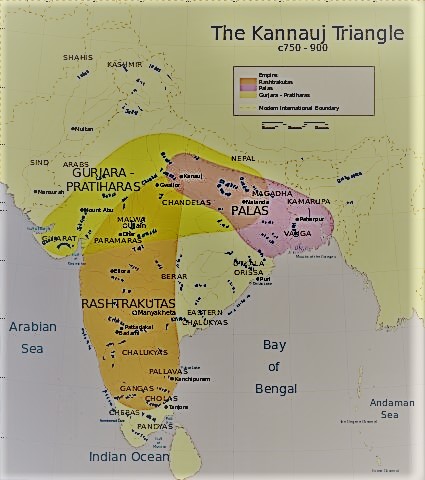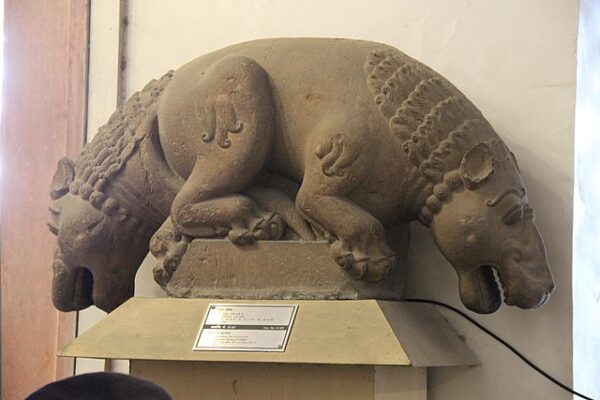There was no powerful ruler in North India for a long time after the reign of Kushanas and Andhras. For almost a century, India was divided into many independent states.
The main features of this period are their mutual struggle and rise-fall. They were both republics and monarchies and the political situation was much like that of the 6th century BC.
According to Altekar, in general, the monarchical system of governance was more prevalent and that is why the system related to governance was called ‘Rajdharma’ or ‘Rajshastra’.
Altekar sir had written that in the war between the demons and the gods when the gods started getting defeated again and again, they considered the situation of their defeat and came to the conclusion that the reason for their defeat was that they have no ruler of their own.
Then he made Soma his king and won the battle. Thus the monarchy was established. Although Indra is also said to be the king in some places it is of Varun.
Rise and fall is an eternal law of nature. No powerful ruler can remain organized due to feelings of selfishness, greed and luxury. Many empires emerged in similar circumstances.
At about the beginning of the 4th century AD, a king named Srigupta or Gupta ruled a small kingdom of Magadha under which some part of Bengal was also included. After that, his son Ghatotkacha became the ruler. Father-son did not have any remarkable power, but from the time of Ghatotkacha’s son Chandragupta, a new chapter in the history of this dynasty started.
Gupta Period Reached, Indian Society
By the time the Gupta period reached, Indian society had progressed a lot. Most of the information about the Guptas comes from the Puranas.
It is known from the study of Puranas that the name of the Gupta dynasty has come from the following Puranas – Vayu Purana, Matsya Purana, and Vishnu Purana. The introduction of Guptasha is also found in the description of Chinese travelers and in Sanskrit literature.
The first ruler and founder of the Gupta dynasty was a king named Srigupta. Srigupta was also adorned with the title “Maharaj”. After Shrigupta, Ghatotkach was the successor of this rule and after that, from 349 to 335 AD, Chandragupta I was decorated with the title of ‘Maharajadhiraja’ for his bravery. Chandragupta Pratha became the powerful and influential ruler of the Gupta dynasty.
Being ‘Maharajaghiraj’ also indicates that Chandragupta I extended the small area of his state from all sides and made it an important huge state.
Chandragupta I started expanding his power in the field of politics by establishing a matrimonial relationship with Lichchavi princess Kumaradevi for the expansion of his kingdom.
The matrimonial relationship with Lichchavi has been given utmost importance because the social, economic, religious and political status of Lichchavi was very strong in that era.

It was from here that the influence of the Gupta dynasty began to spread in the form of great dynasties and the empire of the Guptas began to expand. This Licchavi princess proved to be very fortunate for Chandragupta Prathath.
Establish Relations with the Lichchhavis
At that time it was a matter of great pride to establish relations with the Lichchhavis. For this purpose, Chandragupta I also inscribed the word Lichchhavi on his seals and popularized his son as “Lichchhavi-Dauhitra”.
In this way, it is also known that the marriage of Lichchhavi Kumaradevi gave Chandragupta Pratha social respect, political power and possibly: Some states also received in the form of a dowry.
The kings of ‘The Gupta dynasty’ were Kshatriyas. There is evidence of their marriage relations with Kshatriya clans like Lichchavi and Vakataka. It is an illusion to consider him a Vaishya because of the word ‘Gupta’ attached to his name.
Mahamahopadhyay Gorishkar Ojha has written in the history of Rajputana that even after the destruction of the kingdom of Guptas, their descendants ruled over Magadha, Madhya Pradesh and Guttal (Bombay province) etc. Shri Gupta or Gupta was the founder of the new dynasty of Magadha which became famous by the name of Shrigupta.
He is considered to be a lunar ruler. Etsig, a Buddhist traveler from China, who came to India at the end of the seventh century, has written in his travelogue that about 500 years ago, Maharaj Shrigupta donated 24 grams to the pilgrims of China and also built a temple.
Etsig himself had seen the ruins of these temples. The story of his gratitude towards the Chinese travelers was heard by the Chinese traveler Etsing in the country of Magadha.
After Chandragupta I, his son Samudragupta succeeded to the throne. Samudragupt is counted among the great and versatile soldiers of the country.
His reign was full of elaborate military campaigns. First of all, he waged a war against the neighboring states of North India to annex them. In the north he had reached Chambal. All the kings of this region were killed and their territories were included in the Gupta Empire.
Samudragupta is Considered a very Successful Ruler
Samudragupta is considered a very successful ruler because of his works. In the southern campaign, more than a dozen kings were defeated in the war and many were taken prisoner, but Samudragupta did not wish to have permanent rule over their territories. So he adopted a wise policy of re-establishing them. He was fully aware of the limits of his power and means.
If Samudragupta had tried to rule the whole of India like Ashoka, the Gupta Empire would probably have ended soon like his empire, but due to his political foresight, the extensive empire that Samudragupta left grew gradually and his successors very efficiently protected the rule more than one hundred years.
Like Chandragupta Prathana and Samudragupta, if the other rulers of Guptasha had been equally visionary in the coming years, then possibly the period of Gupta rule could have been longer.
Those who were independent in name, but they had considered accepting the subordination of the great Gupta emperor to be politically creditable for themselves. This can be considered an example of a classless treaty, in which powerless nations make a treaty of subordination to a powerful nation.
The fourth class was of those 42 states of the south, whose rulers were defeated and reinstated. They had to pay taxes and were not free to take external policies or decisions.
The Personality of Samudragupta, Rajkavi Harishen
Regarding the personality of Samudragupta, Rajkavi Harishen has written in a long praise inscribed on the Ashoka pillar at Prayag that Emperor Samudragupta was not only the first soldier of his era but was also a high-class politician and cultured ruler.
Rajkavi Harishen has written while describing his characteristics that he was not only brave and skilled in war, but he was also a scholar, a poet and a musician of a high order. In fact, this is not just a pure imagination of Rajkavi Harishen, but Samudragupt has also inscribed playing Veena on some of his coins, which proves his musicianship completely.
Interest in education, business and art is also a great confirmation of the economic prosperity of an advanced and developed state, because when a ruler who is policy-oriented, pro-patriotic and follows Rajdharma, fulfills all kinds of life-useful needs of the people with sacrifice, he becomes economically prosperous. And with the progress of business, the people also progress in all fields, only then did the people who are tired of doing hard labor get royal shelter by turning to artifacts.

Only a prosperous nation feels happy by turning towards art and education. The birth of art is an indicator of the prosperity of the state. Art has its own important place in human life. Art leads man towards Satyam Shivam Sundaram. “A man without literature, music and art has been considered like an animal without tail and horns.”
Gupta Architecture, Signs of the Beginning
Ghildiyal has also written that wisdom is transmitted towards prosperity, peace and contemplation works only when the surrounding environment is calm and human is completely free from the pyre of food and cover.
In Gupta architecture, signs of the beginning of the new age are found along with the ancient tradition. In the field of sculpture, Gupta sculptures can be called completely Indian and ideal from every point of view. The Buddha statues of Sarnath and Mathura ooze grandeur and peace.
The development of the full form of divinity is reflected in the idols of Brahmin deities like Shiva, Vishnu, etc. engraved in the Deogarh temple. These facts have also been confirmed in the book “The Classical Age“.
Chandragupta II contributed almost as much as Samudragupta in the growth of the Gupta Empire. Among the later Gupta rulers, Skandagupta was gratefully seen as ‘Deshtrata’ by the countrymen for defeating the Huns. This was the last great empire of the Gupta Empire.
After the fall of the Gupta Empire, many new dynasties emerged in India. According to Romila Thapar, the political situation from the reign of the Guptas to the rise of Harsha at the beginning of the seventh century is not very clear due to the lack of sufficient evidence.
The way Baan has addressed Prabhakarvardhan – “Huna Harin Kesari”, “Sindhuraj fever, “Lataparshu” etc. The plan and policy of Prabhakarvardhan’s military victory were completed by Harshavardhan, whose reign started in 606 AD.
The Maitrak dynasty of Balbi was founded by a person named Bhattarak. Although the exact date of the establishment of Maitrak state could not be determined, the first land donation by Maharaja Dronasingh is mentioned in 502 AD, because all the initial donations are mentioned only from Balbhi, so it can be said with certainty that Balbhi From the beginning, their capital was Majumdar has described it in chapter eight of “The Classical Age”. There is also a belief that this dynasty originated in Iran.

